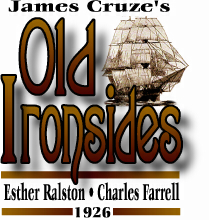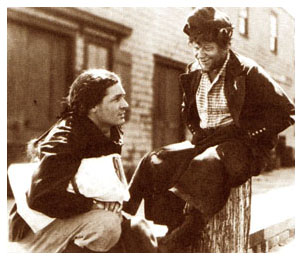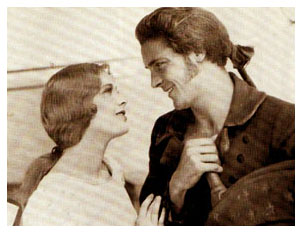

Cast: Esther Ralston (the girl), Charles Farrell (the boy, nicknamed "Commodore"), Wallace Beery (the bos'n), George Bancroft (the gunner), George Godfrey (the cook) Johnnie Walker (Lt. Stephen Decatur), Guy Oliver (first mate), Eddie Fetherston (Lt. Somers), Effie Ellsler (the girl's mother), William Conklin (the girl's father), Fred Kohler (second mate), Charles Hill Mailes (Commodore Preble), Spec O'Donnell (cabin boy)
Rather than pay tribute to pirates in the Mediterranean,
the U.S. government in 1798, though young and with limited financial
resources, decides to free the seas of marauding pirates and sends
two ships, the U.S.S. Philadelphia and the newly constructed U.S.S.
Constitution, nicknamed Old Ironsides, to fight. A young farm
boy sees a poster calling for sailors for the Constitution and
leaves homes to join the crew. He is met by the bos'n of the Esther
who shanghais him along with the gunner of the Constitution. The
Esther is taking the daughter of its owner to Italy. They are
soon captured by pirates and taken to sell as slaves. The girl,
rather than being sold as a slave, is being held as a present,
along with the ship, for the Sultan. The Philadelphia has also
been captured leaving this nearly impossible mission up to the
Constitution. The bos'n, the gunner, the boy and the black cook
of the Esther are chained together, but manage to escape in a
rowboat and find the Constitution. They join in the rescue of
the girl and the crew of the Esther and the defeat of the pirates.
"No matter what the production of 'Old Ironsides' cost, the executives of the Famous Players-Lasky organization were able to go home Monday night after the opening at the Rivoli and sleep well for no matter what the investment, the picture represents they are sure to get it all back and a whole lot more." -- Variety, December 8, 1926
"It's a glorious story of a glorious achievement." - Photoplay, February, 1927
"All of the superlatives in the newest dictionary are needed for the recommendation of 'Old Ironsides,' which takes rank with the screen's biggest achievements." - Motion Picture Classic, February, 1927
The praise for the film goes on, but, surprisingly, it was "a dismal failure" at the box office. A viewing of this film today makes this difficult to imagine for, inevitably, the present-day viewer will agree with the critics of 1926-27 who saw James Cruze's production as a great cinematic achievement, and certainly it is. And the viewer doesn't need to "make allowances" because this is a silent era film. "Old Ironsides" stands as a superb film, technically and otherwise, from any era.
Even the staid New York Times reviewer who consistently practiced great restraint when offering any level of praise, said, "The story has its full share of hokum, but it is the sort of stuff that one enjoys." The Variety reviewer seemed to be hardly able to contain himself in revering the film. "'Old Ironsides' as a picture has everything that one could ask for. There is a love story that stands out tremendously, there is a comedy element ever present in the personages of Wallace Beery, George Bancroft and George Godfrey (the latter the colored heavyweight pugilist who is a whale of a screen comic as paired up with Beery and Bancroft), there is the patriotic element which just goes to prove that George M. Cohan was right when it comes to waving the flag for an audience in this country, and above all, the stirring spectacle as embodied in the battle scenes."
The "comedy element" is mentioned several times
in the vintage reviews, but it must be noted that Cruze does not
attempt to make us laugh with broad humor or, as we might suspect,
racial humor because of the inclusion of the black cook. The humor
in this movie works because it is blended in as a part of the
story and not inserted just for its own sake. Also, it is shared
equally by the bos'n (Wallace Beery), the gunner (George Bancroft)
and the black cook (George Godfrey). For example, the boy goes
down to the kitchen to get warm, but the cook tells him he must
remove the skin from the potatoes if he is to stay. The boy is
admonished for actually peeling the potatoes since this is considered
a "waste." Instead, the cook insists that he scrape
the potatoes. Then the girl comes below and sweetly tells the
boy it's a waste of time to scrape the potatoes. It's much faster
to peel them. Then the cook forms an opening using the thumb and
forefinger of both hands and spits through it for good luck. You
see, he believes women on a ship bring bad luck. This is the type
of humor that the film provides -- not soliciting loud guffaws,
but nonetheless pleasing. The battling between the two big men,
the bos'n and the gunner, also provides some humorous situations.
One of the best comes when they are back on the Constitution,
and the gunner tells the bos'n to get him some vinegar to clean
the cannon. The bos'n complains, "You can't order me about!
I'm a guest on this boat." At that, the gunner knocks the
bos'n to the deck, and smiling wickedly, says, "Well . .
. you guest wrong!" Finally, to Cruze's credit (and remember
this is 1926), George Godfrey's color was not exploited for humor.
Cruze uses one running joke for Godfrey's character - the bit
where he spits through his fingers for good luck. Also, when the
four men are captured and sold as slaves, there is no distinction
between each one as they are chained  together
and escape to freedom.
together
and escape to freedom.
As with any good epic -- from "The Birth of a Nation" (1915) to "Titanic" (1997) -- the success rests on effectively bringing the great canvas of history down to a personal level. Cruze does a wonderful job with the love story between the boy and the girl and the misadventures of the bos'n and the gunner. We are even treated to some historical figures in the persons of Stephen Decatur, Thomas McDonough (whom we are told won the battle of Lake Champlain) and James Lawrence (whose dying words on the deck of the Chesapeake were "Don't give up the ship").
Cruze was well aware that big battle scenes with plenty of action, lots of explosions, and mass mayhem are good stuff for the movies, but he also understood that we must know some of the players intimately and feel some urgency about their fate during this climax. We are certainly kept on the edge of our seats about the girl's fate. She was left behind in the hands of the pirates when the four men escaped. As the boy is trying to get to her during the battle, Cruze makes it obvious she is in danger and heightens this danger by emphasizing the sexual menace, as well. The rescue of the damsel in distress may not be the most original idea, but it's certainly the most effective, especially as we see the disgusting pirate clawing at her dress and trying to drag her down below as the boy fights to rescue her.
Not to take anything away from Cruze, but the story would have been only half as good if the casting had not been done so well. Esther Ralston, Charles Farrell, Wallace Beery and George Brent seemed to have been made for their parts, and it's difficult to imagine anyone else portraying their characters. "Honors are fairly evenly divided among the performers, although Beery and Bancroft, if anything, get the best of the show. Miss Ralston is attractive as the heroine. Charles Farrell is exceptionally competent as the Boy. George Godfrey vies with Beery and Bancroft as a comedian. He, it is, who as a ship's cook does not believe in women aboard a ship," said The New York Times reviewer. Variety said, "Charles Farrell, who plays the hero, is a find if there ever was one. He has been around pictures for a time but he has never done anything as outstanding as his work in this picture. He got his chance here, and from now on it is made. Esther Ralston, as the heroine, is truly magnificent. She holds her own every minute."
In films such as this where the characterizations are dominated by men, one would suspect the feminine lead to simply be an adornment. However, Ralston's character is given a real presence in the movie, and she handles it well. Her presence on the ship is certainly a distraction to the boy, and when she flirts with him while he is supposed to be manning the wheel and keeping an eye on the "t'gallant sail" so the ship will stay on course, he can't stand it any longer. He leaves the wheel, grabs her and kisses her passionately. Unfortunately, the ship sways sharply and waves come crashing over the side knocking both of them down and drenching the sleeping quarters of the men below. Viewing the film it is easy to see why the boy was distracted as Ralston does a superb job of being coquettish and winning him (and the viewer) over with her charms.
In her autobiography Some Day We'll Laugh (The Scarecrow Press, 1985), Ralston said she usually wore bloomers which reached down to her ankles every day because she was the only female among an otherwise completely male cast. One day her hairdresser came to her and said, "Mr. Cruze wants the bloomers off for the next scene." This was the scene in which she was to flirt with the boy at the wheel of the ship. Cruze's plan was to have the wind blowing against her dress outlining her figure. Certainly his idea worked well as Ralston's figure is outlined clearly with the stiff wind pressing the thin material against her shape -- almost erotic. No wonder the boy couldn't control himself!
Also, at the end of the big battle, the boy is fighting
off one pirate after another in his attempt to rescue the girl.
The girl, however, is not standing around wide-eyed and helpless,
and, much to Cruze's credit, we don't have several shots of the
girl with the back of her hand to her mouth recoiling, wide-eyed,
in fear. Instead, Cruze has the girl pick up a pistol, and, just
as it seems the boy may be overcome by the pirate, she slams the
butt of the gun against the pirate's head. Exciting stuff and
 much more satisfying than the usual
helpless female.
much more satisfying than the usual
helpless female.
"Old Ironsides" was filmed off the coast of Catalina. Some miniatures were used, but the effects are very well done. Full-sized ships were used for the Constitution and the Esther. Ralston noted in her autobiography that the Esther was an old ship that had been reconditioned for the movie but was still unseaworthy. "On our first day's shooting, the steering wheel broke and we headed full sail for the mainland until a tug boat rescued us."
The most harrowing experience happened when they were to film the fog scenes. This was only supposed to take an hour or so, but a storm came up and swept the Esther out to sea along with the cast and about 150 other men. A tug boat was with them, but it couldn't move the ship against the force of the storm and eventually ran out of gas. According to Ralston, "About one-thirty in the morning, the captain of the Esther came into the cabin and told me we were being driven by the wind into San Pedro harbor and were headed straight or Devil's Rock." He told them the ship would be "smashed to bits." Finally, someone decided to climb the mast, ties cloths at the very top and them on fire. The Coast Guard saw the flames and sent a speedboat to rescue the ship.
Filming on the movie began on March 14 and ended in June of 1926. When the movie premiered at the Rivoli in New York December 6, 1926, it was shown using a new projection gimmick called Magnascope. Developed by Glen Allvine of the Famous Players-Lasky Corporation, it simply called for a magnification lens attached to the projector. Rather than the 12 by 18 screen, the image was enlarged to 30 by 40 feet. "This wide angle screen was tremendously effective in the scenes of fighting aboard the old frigate off the cost of Tripoli, and also in those pictures of the imposing productions of the forts, with old-fashioned guns booming and the missiles splashing in the sea," said The New York Times reviewer. Other viewers were equally impressed by the invention.
It is interesting to note that film historian Lewis Jacobs, just 13 years after "Old Ironsides" was made, wrote in his The Rise of the American Film (Harcourt, Brace and Company, 1939), "This film on an American historical subject proved to be a dismal failure. It was now clear that such material was entirely unfit for Cruze and that his success with 'The Covered Wagon' had been a flash in the pan . . . (he) lacked the integrity of a von Stroheim and was unable to make any valuable contributions to American films. . . Cruze remains a minor figure whose talents were unrealized." Fifty-one years later, Richard Koszarki (An Evening's Entertainment: The Age of the Silent Feature Picture, 1915-1928 , University of California Press, 1990), chose to differ with Jacobs' assessment. "Lewis Jacobs may have been reflecting here the hostility of the moment, but his harsh assessment of 'Old Ironsides' seems hard to justify in light of recent screenings."
In The Films of the Twenties (Citadel Press, 1985) author
Jerry Vermilye gave high praise to Cruze and "Old Ironsides."
"All of this is directed with amazing coordination by James
Cruze, whose reputation today hangs mainly on 'The Covered Wagon,'
that landmark Western epic he directed for Paramount in 1923.
But 'Old Ironsides' surely seems deserving of equal respect for
its meticulous attention to maritime detail, with only the slightest
recourse to any use of miniatures. And Cruze's direction of a
huge cast is deceptively smooth, from the relatively inexperience
Charles Farrell to 'comedy relief' character  actors
Beery and Bancroft and, as the Esther's amusingly gruff black
cook, real-life heavyweight champ George Godfrey in his movie
debut. Some sixty years later, 'Old Ironsides,' aside from the
silence of its performers, seems scarcely dated at all."
actors
Beery and Bancroft and, as the Esther's amusingly gruff black
cook, real-life heavyweight champ George Godfrey in his movie
debut. Some sixty years later, 'Old Ironsides,' aside from the
silence of its performers, seems scarcely dated at all."
The copy that is reviewed here is the Paramount video that is no longer in print. Although the trend in providing orchestral scores for today's DVD's is commendable, there is much to be said for the scores we enjoyed for so many years on Super 8mm film and VHS tapes by such greats as Gaylord Carter, William Perry, John Muri and others. This is one of those movies for it has a superb score by Gaylord Carter "performed on the magnificent Wurlitzer organ" that is rousing, moving and mesmerizing. Certainly one would think that an epic such as this would require a full orchestral accompaniment for the complete movie experience, but this Gaylord Carter score does not disappoint. It must be kept in mind that a score, whether a lone piano or a full orchestra may not be satisfying if the composer/conductor/performer does not have an understanding of and familiarity with silent movies. There are silent movies available today with specially composed orchestra scores that are not only unsatisfying but inappropriate for the movie. Carter spent a lifetime playing for silent movies. His scores never fail to be right on target for every scene, every mood, every nuance.
The real U.S.S. Constitution survives to this day. On July 8, 1997, the newly restored ship sailed on a brief voyage under its own power for the first time since 1881.
Laurence Stallings, who also had "The Big Parade" (1927) to his credit, wrote the story. According to Variety, "Laurence Stallings who did the tale for the picture, has taken a couple of liberties with history to plant love story, but he has done this so skillfully that no one is going to object."
Director James Cruze died in poverty in 1942 having suffered from chronic alcoholism.
Copyright 2004 by Tim Lussier. All rights reserved.